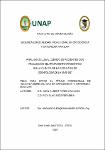| dc.contributor.advisor | Moura García, Ana María Joaquina | |
| dc.contributor.author | Pérez Cahuaza, Jhon Albert | |
| dc.contributor.author | Ríos Ferreira, Roy Elvis | |
| dc.date.accessioned | 2019-05-21T14:41:16Z | |
| dc.date.available | 2019-05-21T14:41:16Z | |
| dc.date.issued | 2019 | |
| dc.identifier.uri | http://repositorio.unapiquitos.edu.pe/handle/20.500.12737/6128 | |
| dc.description.abstract | El objetivo del estudio fue determinar las características de la oclusión de los pacientes durante la fase final del tratamiento ortodóntico en la clínica de la facultad de odontología de la UNAP durante el año 2017. El tipo de investigación fue cuantitativo, de tipo descriptivo. La muestra estuvo conformada por 80 pacientes que cumplieron con los criterios de inclusión. Los resultados son: En la relación molar derecha el 92,4% fue clase I, el 3,8% fue clase II y clase III respectivamente. En relación molar izquierda el 95% fue clase I, el 2,5% fue clase II y clase III respectivamente. En la relación canina derecha el 95% fue clase I, 2,5% fue clase II y clase III respectivamente. En la relación canina izquierda el 87,4% fue clase I, el 1,3% fue clase II y el 2,5% fue clase III. En el overbite el 98,7% fue normal y en el overjet el 92,5% fue normal. En la línea media del maxilar superior el 97,5% fue normal y en el 2,5% estuvo desviado. En la línea media del maxilar inferior el 96,2% fue normal y en el 3,8% estuvo desviado. En relación a la guía canina derecha, en el lado de trabajo el 87,5% no presentó interferencias, el 7,5% presentó interferencias y en el 5% presentó función de grupo. En el lado de balance el 92,5% no presentó interferencias y en el 7,5% presentó interferencias. En relación a la guía canina izquierda, en el lado de trabajo el 93,7% no presentó interferencias, el 3,8% presentó interferencias y en el 5% presentó función de grupo. En el lado de balance el 93,7% no presentó interferencias y en el 6,3% presentó interferencias. En la guía incisiva el 90% no presentaron interferencias y en el 10% tuvieron interferencias. En relación al análisis de oclusión el 70% tuvieron oclusión normal y en el 30% tuvieron oclusión alterada. Se concluye que el mayor porcentaje de pacientes que están por terminar el tratamiento de ortodoncia presentan una oclusión óptima dentro de los parámetros analizados en este estudio. | es_PE |
| dc.description.abstract | The objective of the study was to determine the characteristics of the occlusion of patients during the final phase of orthodontic treatment in the clinic of the dental school of the UNAP during the year 2017. The type of research was quantitative, descriptive. The sample consisted of 80 patients who met the inclusion criteria. The results are: In the right molar ratio 92.4% was class I, 3.8% was class II and class III respectively. In left molar ratio 95% was class I, 2.5% was class II and class III respectively. In the right canine relationship, 95% was class I, 2.5% was class II and class III, respectively. In the left canine relationship, 87.4% was class I, 1.3% was class II, and 2.5% was class III. In the overbite, 98.7% was normal. In the overjet, 92.5% was normal. In the midline of the maxilla, 97.5% was normal and 2.5% was deviated. In the midline of the lower jaw 96.2% was normal and in 3.8% was deviated. In relation to the right canine guide, on the work side 87.5% did not present interferences, 7.5% presented interference and in 5% presented group function. On the balance side, 92.5% did not present any interference and 7.5% presented interference. In relation to the left canine guide, on the work side, 93.7% did not present any interferences, 3.8% presented interferences and in 5% presented group function. On the balance side, 93.7% did not present any interference and 6.3% presented interference. In the incisive guide 90% not presented interferences and in 10% they did have interferences. In relation to the occlusion analysis, 70% had normal occlusion and 30% had altered occlusion. It is concluded that the highest percentage of patients who are about to finish orthodontic treatment have an optimal occlusion within the parameters analyzed in this study. | en_US |
| dc.description.uri | Tesis de segunda especialidad | es_PE |
| dc.format | application/pdf | es_PE |
| dc.language.iso | spa | es_PE |
| dc.publisher | Universidad Nacional de la Amazonía Peruana | es_PE |
| dc.rights | info:eu-repo/semantics/openAccess | es_PE |
| dc.rights.uri | http://creativecommons.org/licenses/by-nc-nd/3.0/us/ | * |
| dc.source | Universidad Nacional de la Amazonía Peruana | es_PE |
| dc.source | Repositorio institucional - UNAP | es_PE |
| dc.subject | Oclusión dental | es_PE |
| dc.subject | Análisis clínico | es_PE |
| dc.title | Análisis oclusal clínico en pacientes con finalización del tratamiento ortodóntico en la clínica de la facultad de Odontología de la UNAP 2017 | es_PE |
| dc.type | info:eu-repo/semantics/bachelorThesis | es_PE |
| thesis.degree.discipline | Odontología | es_PE |
| thesis.degree.grantor | Universidad Nacional de la Amazonía Peruana. Escuela de Posgrado | es_PE |
| thesis.degree.level | Título de Segunda Especialidad | es_PE |
| thesis.degree.name | Segunda Especialización Profesional en Ortodoncia y Ortopedia Maxilar | es_PE |
| thesis.degree.program | Regular | es_PE |
| dc.subject.ocde | http://purl.org/pe-repo/ocde/ford#3.02.14 | es_PE |


